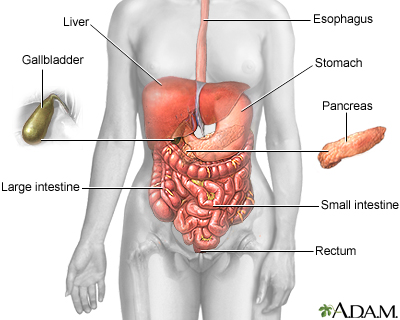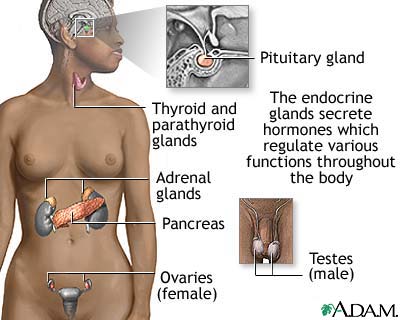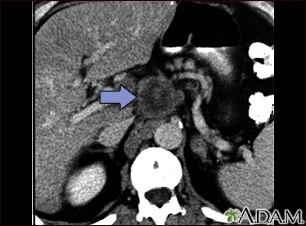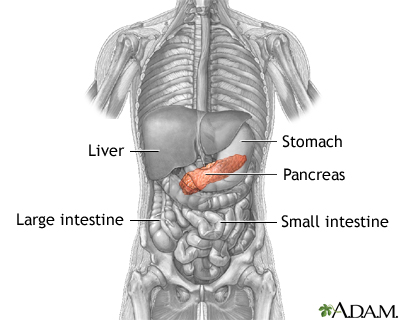Health Library
Pancreatic cancer
Pancreatic cancer; Cancer - pancreas
Pancreatic cancer is cancer that starts in the pancreas.
Images




Presentation

I Would Like to Learn About:
Causes
The pancreas is a large organ behind the stomach. It makes and releases enzymes into the intestines that help the body digest and absorb food, especially fats. The pancreas also makes and releases insulin and glucagon. These are hormones that help the body control blood sugar levels.
There are different types of pancreatic cancers. The type depends on the cell the cancer develops in. Examples include:
- Adenocarcinoma, the most common type of pancreatic cancer
- Other more rare types include glucagonoma, insulinoma, islet cell tumor, VIPoma
The exact cause of pancreatic cancer is unknown. It is more common in people who:
- Are obese
- Have a diet high in fat and low in fruits and vegetables
- Have diabetes
- Have long-term exposure to certain chemicals
- Have long-term inflammation of the pancreas (chronic pancreatitis)
- Smoke
The risk for pancreatic cancer increases with age. Family history of the disease also slightly increases the chance of developing this cancer.
Symptoms
A tumor (cancer) in the pancreas may grow without any symptoms at first. This means the cancer is often advanced when it is first found.
Symptoms of pancreatic cancer include:
- Diarrhea
- Dark urine and clay-colored stools
- Fatigue and weakness
- Sudden increase in blood sugar level (diabetes)
- Jaundice (a yellow color in the skin, mucous membranes, or white part of the eyes) and itching of the skin
- Loss of appetite and weight loss
- Nausea and vomiting
- Pain or discomfort in the upper part of the belly or abdomen
Exams and Tests
The health care provider will perform a physical exam and ask about your symptoms. During the exam, the provider may feel a lump (mass) in your abdomen.
Blood tests that may be ordered include:
- Complete blood count (CBC)
- Liver function tests
- Serum bilirubin
Imaging tests that may be ordered include:
- CT scan of the abdomen
- Endoscopic retrograde cholangiopancreatography (ERCP)
- Endoscopic ultrasound
- MRI of the abdomen
Diagnosis of pancreatic cancer (and what type) is made by a pancreatic biopsy.
If tests confirm you have pancreatic cancer, more tests will be done to see how far the cancer has spread within and outside the pancreas. This is called staging. Staging helps guide treatment and gives you an idea of what to expect.
Treatment
Treatment for adenocarcinoma depends on the stage of the tumor.
Surgery may be done if the tumor has not spread or has spread very little. Along with surgery, chemotherapy or radiation therapy or both may be used before or after surgery. A small number of people can be cured with this treatment approach.
When the tumor has not spread out of the pancreas but cannot be surgically removed, chemotherapy and radiation therapy together may be recommended.
When the tumor has spread (metastasized) to other organs such as the liver, chemotherapy alone is usually used.
With advanced cancer, the goal of treatment is to manage pain and other symptoms. For example, if the tube that carries bile is blocked by the pancreatic tumor, a procedure to place a tiny metal tube (stent) may be done to open the blockage. This can help relieve jaundice, and itching of the skin.
Support Groups
You can ease the stress of illness by joining a cancer support group. Sharing with others who have common experiences and problems can help you not feel alone.
Outlook (Prognosis)
Some people with pancreatic cancer that can be surgically removed are cured. But in most people, the tumor has spread and cannot be completely removed at the time of diagnosis.
Chemotherapy and radiation are often given after surgery to increase the cure rate (this is called adjuvant therapy). For pancreatic cancer that cannot be removed completely with surgery or cancer that has spread beyond the pancreas, a cure is not possible. In this case, chemotherapy is given to improve and extend the person's life.
When to Contact a Medical Professional
Contact your provider for an appointment if you have:
- Abdominal or back pain that does not go away
- Persistent loss of appetite
- Unexplained fatigue or weight loss
- Other symptoms of this disorder
Prevention
Preventive measures include:
- If you smoke, now is the time to quit.
- Eat a diet high in fruits, vegetables, and whole grains.
- Exercise regularly to stay at a healthy weight.
Related Information
MalignancyReferences
De Jesus-Acosta A, Narang A, Mauro L, Herman J, Jaffee EM, Laheru DA. Carcinoma of the pancreas. In: Niederhuber JE, Armitage JO, Kastan MB, Doroshow JH, Tepper JE, eds. Abeloff's Clinical Oncology. 6th ed. Philadelphia, PA: Elsevier; 2020:chap 78.
Modi B, Shires GT. Pancreatic cancer, cystic pancreatic neoplasms, and other nonendocrine pancreatic tumors. In: Feldman M, Friedman LS, Brandt LJ, eds. Sleisenger and Fordtran's Gastrointestinal and Liver Disease. 11th ed. Philadelphia, PA: Elsevier; 2021:chap 60.
National Cancer Institute website. Pancreatic cancer treatment (PDQ) - health professional version. www.cancer.gov/types/pancreatic/hp/pancreatic-treatment-pdq. Updated March 17, 202. Accessed May 18, 2022.
National Comprehensive Cancer Network website. NCCN clinical practice guidelines in oncology: pancreatic adenocarcinoma. Version 2.2021. www.nccn.org/professionals/physician_gls/pdf/pancreatic.pdf. Updated February 24, 2022. Accessed May 18, 2022.
BACK TO TOPReview Date: 7/19/2021
Reviewed By: Todd Gersten, MD, Hematology/Oncology, Florida Cancer Specialists & Research Institute, Wellington, FL. Review provided by VeriMed Healthcare Network. Also reviewed by David Zieve, MD, MHA, Medical Director, Brenda Conaway, Editorial Director, and the A.D.A.M. Editorial team. Editorial update 05/18/2022.
 | A.D.A.M., Inc. is accredited by URAC, for Health Content Provider (www.urac.org). URAC's accreditation program is an independent audit to verify that A.D.A.M. follows rigorous standards of quality and accountability. A.D.A.M. is among the first to achieve this important distinction for online health information and services. Learn more about A.D.A.M.'s editorial policy, editorial process and privacy policy. A.D.A.M. is also a founding member of Hi-Ethics. This site complies with the HONcode standard for trustworthy health information: verify here. |
The information provided herein should not be used during any medical emergency or for the diagnosis or treatment of any medical condition. A licensed medical professional should be consulted for diagnosis and treatment of any and all medical conditions. Links to other sites are provided for information only -- they do not constitute endorsements of those other sites. © 1997- 2022 A.D.A.M., a business unit of Ebix, Inc. Any duplication or distribution of the information contained herein is strictly prohibited.
